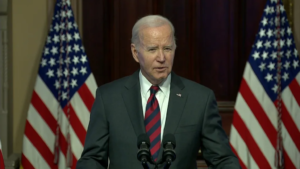In 1984, a prize horse owned by the president of Destron Fearing, a Minnesota-based animal identification company, was stolen. Frustrated, he came up with a solution: an implantable chip that could help identify and recapture stolen animals. After hitting the market in the 1990s, the chip became a huge hit: Some 10 billion versions of the chip were used globally in 2018 alone, found in everything from lost pets to subway cards, electronic tolls and clothing retailers trying to prevent shoplifting.
But that horse theft had another, if unintended, effect. On the eve of the new millennium, the evangelical fundamentalist Kent Hovind published a book online titled Unmasking the False Religion of Evolution. He was followed by Katherine Albrecht, a Christian consumer advocate who wrote the 2005 title Spychips. And as credit cards and wireless payment methods have exploded, doomsayers have migrated from print to platforms like Facebook and YouTube, all warning the same general message: that soon the United States and other world governments will use the chip to track every man, woman and child without their permission. It’s a modern manifestation of the “Mark of the Beast” described in the apocalyptic Book of Revelation as a “mark on their right hands or foreheads” that would keep Christians from buying or selling goods and, in essence, participating in society.
Why does any of this matter now? Because in the last few months, the chip conspiracy has spiraled into an edition tailor-made for 2020; the conspiracy theory that billionaires like Bill Gates are using the COVID-19 pandemic, and an eventual vaccine, as a cover to implant millions of unwitting Americans with a chip containing the mark of the beast. It’s just one of the pseudoscience beliefs used to radicalize Americans against social distancing and health guidelines meant to help curb the spread of the coronavirus and save lives. And in case those conspiracists may seem like a small subset of society, consider this: a Yahoo News/YouGov poll conducted in May found that 44 percent of Republicans believe the Gates-microchip conspiracy to be true, as do nearly a fifth of Democrats and almost a quarter of Independents.
MANY FRINGE MOVEMENTS THROUGHOUT HISTORY EVENTUALLY MERGE INTO THE MAINSTREAM, A PROCESS THAT USED TO TAKE DECADES BUT HAS BEEN ACCELERATED.
Which is to say that America is now occupied territory. The proof begins in the names that form their own amber waves of grain across this strange fruited plain. The killed: George Floyd, Breonna Taylor and a haunted ledger over the decades. The wounded: countless protesters who have lost their eyes or limbs; journalists arrested, pepper-sprayed, shot at by police; those who saw their livelihoods battered by a pandemic and then burned down by looters; those who couldn’t hold the hands of, or bury, their 138,000 dead loved ones, and more, tomorrow.
However, America’s invaders aren’t foreign forces, despite the country’s recent obsession with Russian and Chinese interference. The enemy from within is neither the media, nor the boogeyman deep state, but rather those among us who are warring to make extremist ideologies commonplace. They are the American fringes. And they are quickly becoming the America of tomorrow.
Consider the scene from Baltimore, just two months ago. As cities like Chicago and Minneapolis saw violent proceedings, thousands gathered in the Charm City for a third day of overwhelmingly peaceful marches — a stark contrast to the Freddie Gray protests that lit much of north Baltimore aflame in 2015, and that still burden the city’s most vulnerable communities. “Power. Transformation. Miracles. I need it. I gotta have it. Right now,” a woman said over a megaphone, a chant that would be just as welcome in a Bible study group as it was at that Black Lives Matter rally.
Still, there were other messages, some more aggressive and certainly stranger considering their historical context. In the middle of the procession, a black sedan carried its own messages in bright orange lettering: “BLM” plastered on the driver’s side door and, across its hood, “ACAB,” standing for “All Cops Are Bastards,” a slogan initially popularized by white skinheads. “Because non-racist skinheads … may use this acronym as well as racist skinheads, it should be carefully judged in the context in which it appears,” the Anti-Defamation League says, while listing it as a “hate symbol.”
The popularity of the slogan, which has been echoed online, raises a simple question: How does an extremist slogan that gained prominence in the 1970s from radical, sometimes white supremacist, skinheads, become a rallying cry for a popular, anti-racist African American civil rights movement today? The answer lies in the reality that many fringe movements throughout history eventually merge into the mainstream, a process that used to take decades but has been accelerated in recent years as the fringe finds a home in virtual communities.
THAT’S WHY QANON SUPPORTERS AND ALT-RIGHT TYPES FIND THEMSELVES EMBOLDENED — BECAUSE THEY ARE PART OF THE PRESIDENT’S COALITION.
UNIVERSITY OF MIAMI POLITICAL SCIENTIST JOSEPH USCINSKI
Sure, that can be the case for well-considered public policy: Just four years ago, Medicare for All sat well outside the mainstream. Today it’s a major plank within the Democratic Party and is supported by a majority of the American public.
However, fringe ideas can just as often turn violent. In early June, a joint terrorism task group apprehended three members of the “Boogaloo” — a militant online movement of far-left and far-right members who wear Hawaiian shirts under body armor, bring assault rifles to rallies and believe a second civil war is imminent — for allegedly planning to incite violence at a Las Vegas protest. The loose coalition — some of whom believe Black people are inferior and should be shot, others who stand with Black Lives Matter activists out of a shared disdain for the police — began on the extremist forum 4chan before propagating in Facebook groups and Discord channels. By the end of June, the movement had claimed its first confirmed murder, after a boogaloo boy was charged with gunning down a police officer in Oakland while using peaceful protests as cover.
Meanwhile, President Donald Trump and his allies have fixated on the actions of Antifa, a loosely organized group of left-leaning vigilantes who advocate for direct violence in their fight against those they perceive as fascists, often including the police. Although some viral videos show Antifa members smashing windows and looting, particularly those who dress in all black as part of the Black Bloc, it’s worth noting that even the FBI (an organization not fond of leftist instigators) has found no intelligence tying Antifa to violence at the George Floyd protests.
Regardless of the direct involvement of their members in these recent rallies, Antifa’s influence is evident — many left-leaning activists have mimicked their rhetoric, particularly their anti-cop chants, making the argument that because their name stands for “anti-fascist,” the fringe movement can’t be so bad. Complicating things further, white supremacist groups have posed as antifa groups online to stoke fears and undermine protest groups — another example of how the battle over the most extreme elements of society is fought as much digitally as it is in the streets.

Anti-fascists and Ohio State police face off.
SOURCE SHAY HORSE/NURPHOTO VIA GETTY
There are countless other fringe groups fighting set to become the bedrock of future American values, from the Three Percenters — an anti-government paramilitary group named after the belief that just 3 percent of colonists took up arms against the British in the American Revolution — to QAnon, a group organized around the conspiracy theory that there is a deep-state plot against Trump and his supporters led by pedophile elites. The latter is particularly troubling in its recent rise in prominence, considering that there are now at least 11 Republican nominees for Congress this year who have expressed support for the baseless conspiracy, a few of whom are poised to potentially win.
Many of these groups have their roots in the 2016 presidential election, when Trump openly courted voters outside of the mainstream. From leading the so-called birther movement that alleged President Barack Obama wasn’t actually born in the U.S. to tying GOP rival Ted Cruz’s father to the assassination of President John F. Kennedy, Trump frequently floated bogus conspiracy theories and embraced the fringe. “Now he has to dance with the one that brought him to the prom, so he continues with this rhetoric,” says University of Miami political scientist Joseph Uscinski, who studies mass media with a focus on conspiracy theories. According to a New York Times analysis published in late 2019, Trump retweeted accounts that peddle conspiracy theories, including QAnon, on at least 145 occasions. “That’s why QAnon supporters and alt-right types find themselves emboldened — because they are part of the president’s coalition,” Uscinski says.
***
As the American fringes become more important than ever, OZY will spend the coming months investigating these groups as they fight to become the mainstream of tomorrow. We will look at the Michigan Militia and other gun-rights groups whose rallies against COVID-19 shutdowns have drawn global attention. We will surf the Intellectual Dark Web, a group of classically left-leaning professors and intellectuals fighting against what they see as a culture allowing politically correct rhetoric to supersede science. And we will look at the ways that extremist ideologies have infiltrated our public institutions, including the police, to help precipitate this era of conflict.
In profiling these fringes, our goal is not to praise or condemn. Rather, it is to shed light on the forces battling for the attention and, ultimately, the hearts and minds of the American people. The final stanza of the Matthew Arnold poem “Dover Beach” describes society as “on a darkling plain, Swept with confused alarms of struggle and flight, where ignorant armies clash by night.” Only through understanding these strange, clashing forces can the extremist occupation of America end.




